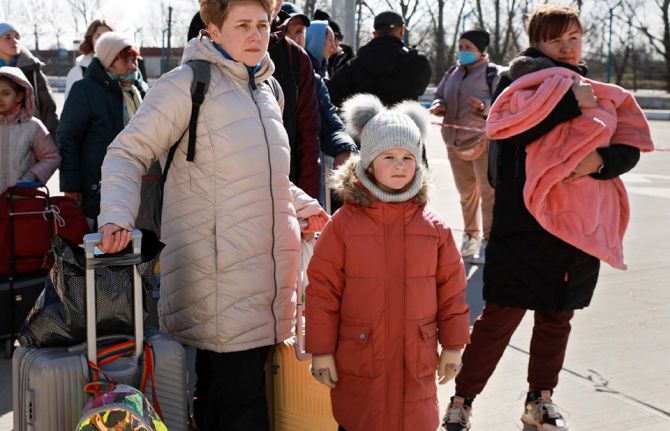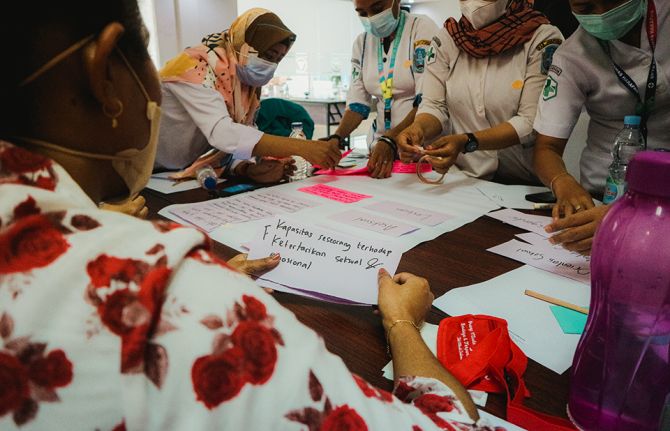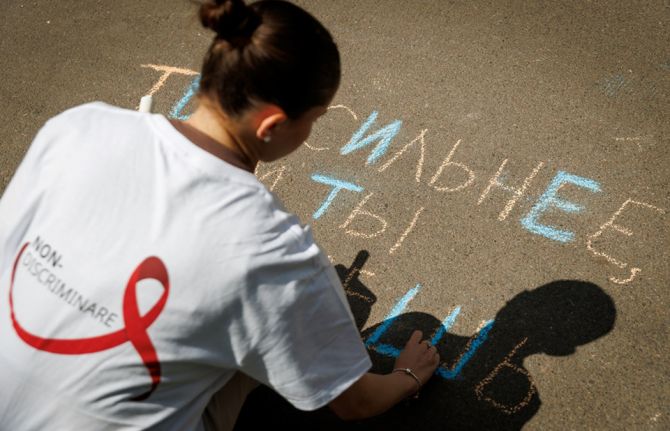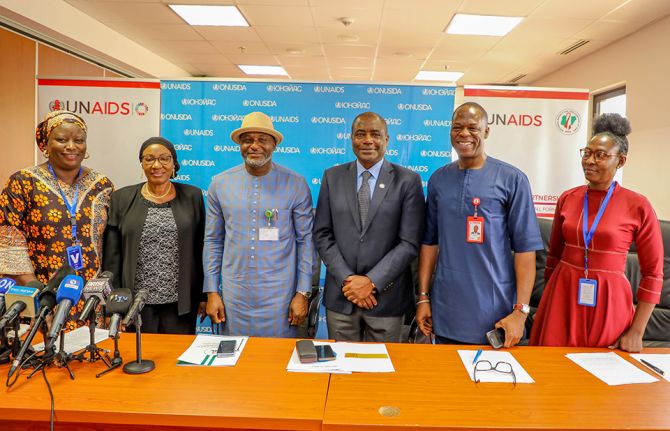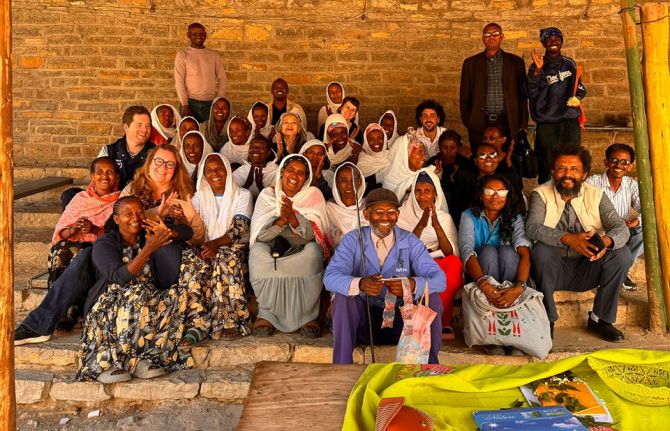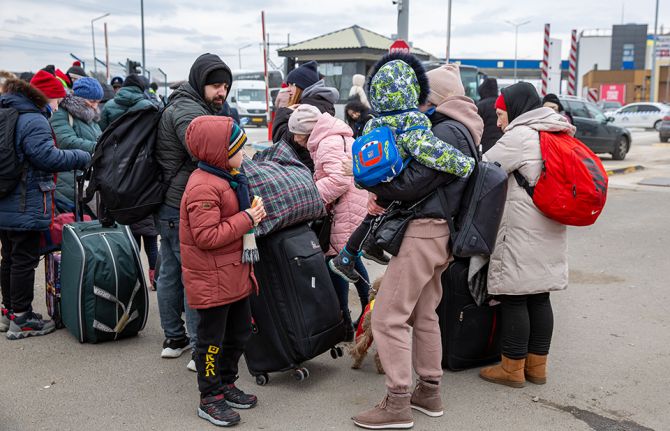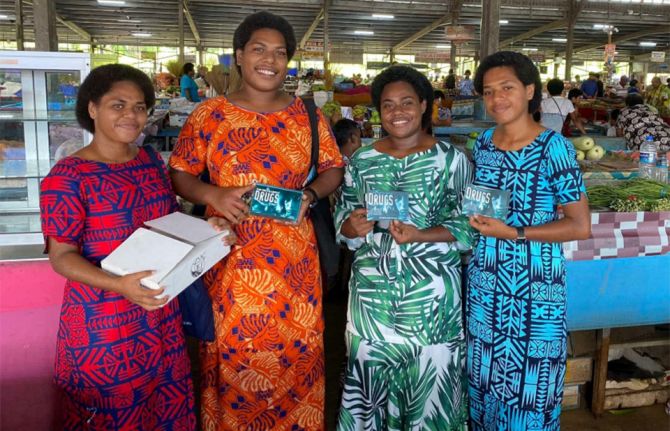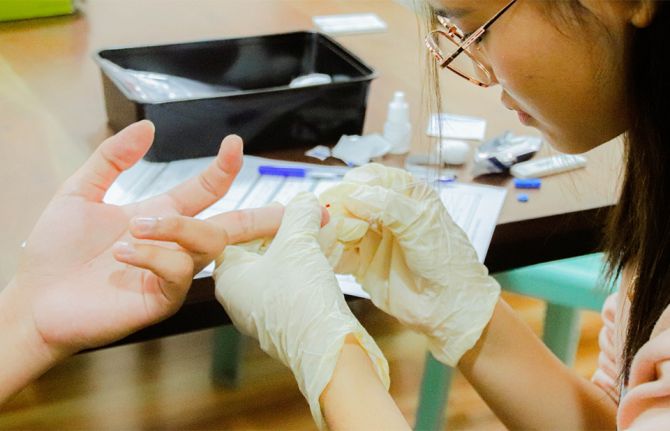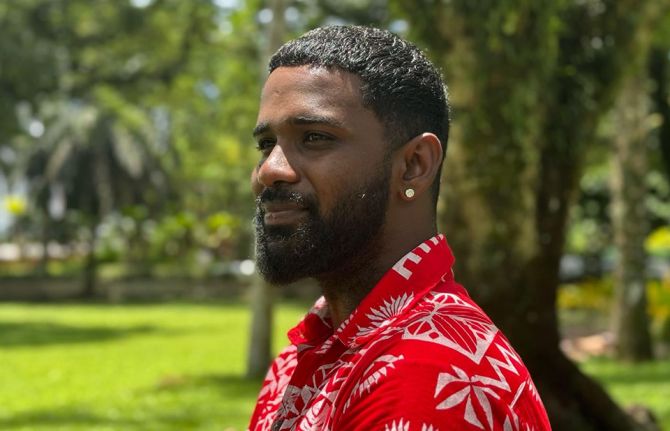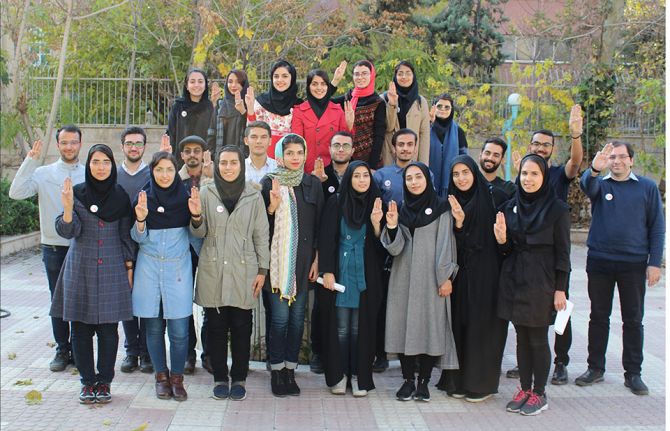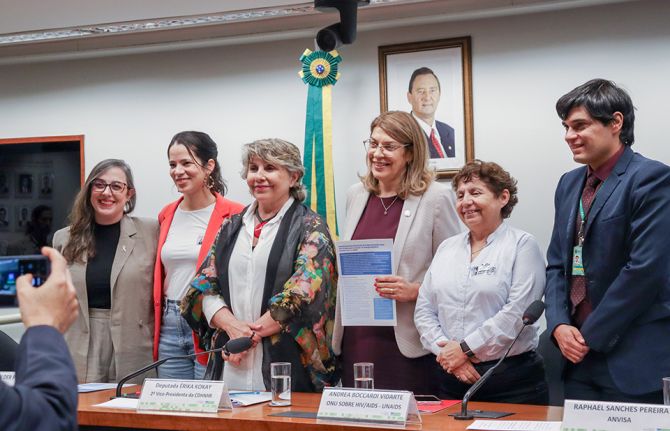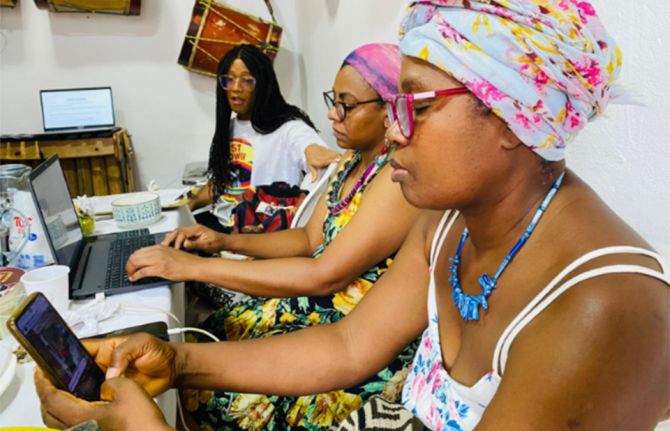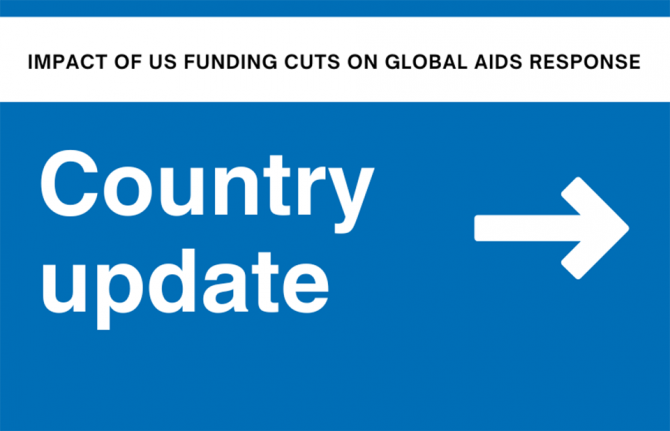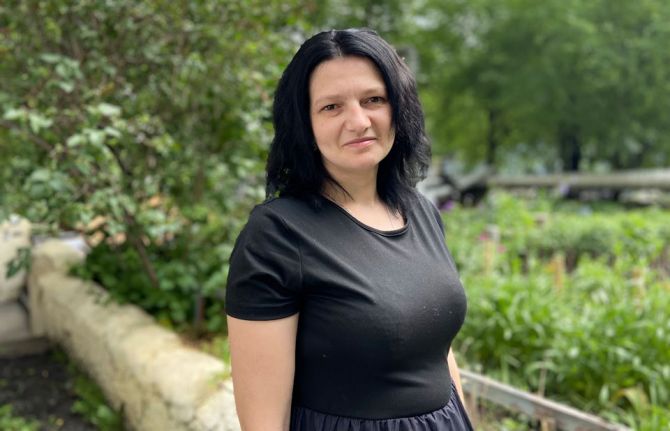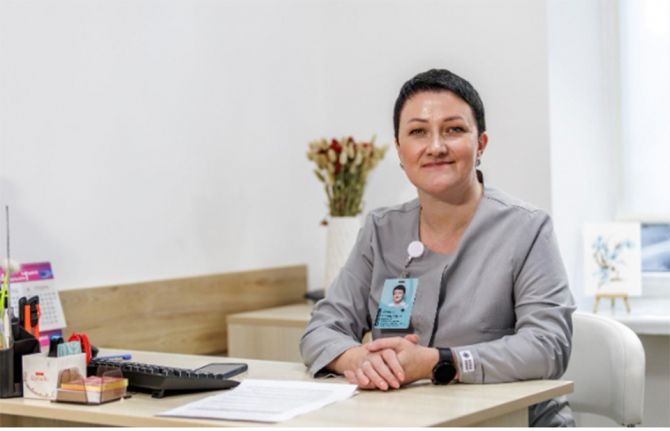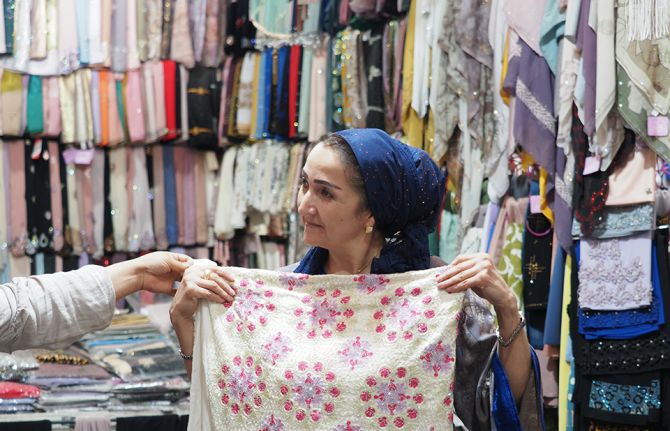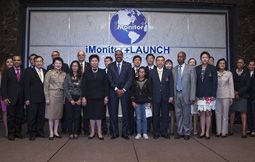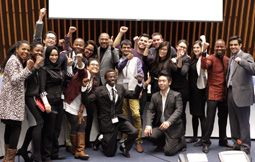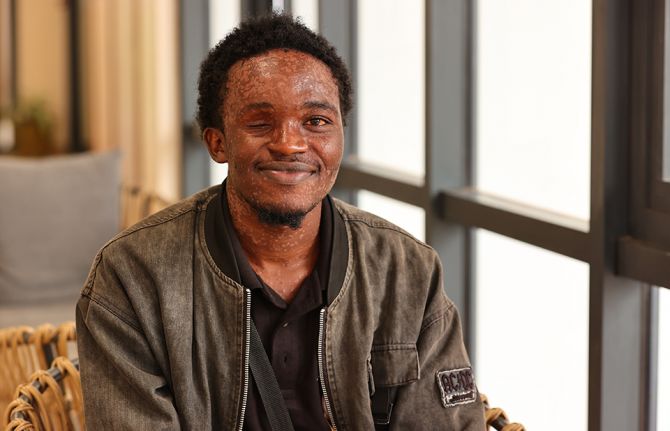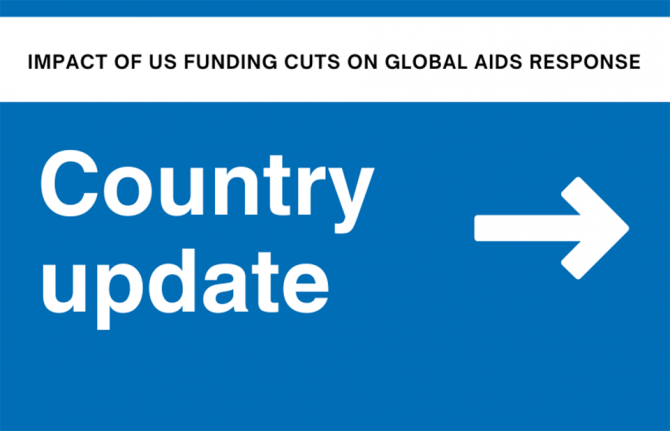
Feature Story
A sustainable HIV response: New global health sector strategy to help chart the way forward
23 May 2011
23 May 2011 23 May 2011
The World Health Assembly today adopted a new comprehensive Global Health Sector Strategy for HIV/AIDS 2011-2015, spearheaded by the World Health Organization (WHO). The strategy aims to provide a detailed and comprehensive guide to how health sectors can most effectively tackle the epidemic.
Recognizing that the nature of the epidemic has evolved in recent years, and that the AIDS response has to be dynamic and flexible, the World Health Assembly in 2010 called for a new HIV strategy to inform global health sector action. In consultation with some 100 member states, civil society and other key players, a number of whom participated online; a strategy has been formulated which takes into account great strides made in the AIDS response and maps out what needs to be done in the future.
The latest UNAIDS global report has shown that the AIDS epidemic has been halted and that the spread of HIV is beginning to be reversed. New infections have fallen by almost 20% in the last 10 years and between 2003 and 2009 there was a 13-fold increase in treatment coverage. However, in 2009 only a third of people in need of treatment received it and the demand for resources is still outstripping supply.
The new Global Health Sector Strategy for HIV/AIDS, which is fully aligned with, and complements, the UNAIDS strategy 2011-15, Getting to Zero, will operate within this changed landscape to optimize progress towards universal access and the attainment of the Millennium Development Goals. It promotes tailored responses to national and regional epidemics and analyzes the underlying socio-economic and cultural determinants contributing to the spread of the virus.
The strategy seeks to reduce vulnerability and structural barriers to accessing good quality services. It also demonstrates how HIV programmes can play a role in broader health outcomes and recognizes the importance of strong health and community systems to guarantee a sustainable response.
WHO will make five key contributions to the Global Health Sector Strategy:
- Scale up innovation in prevention
- Optimize treatment and care
- Support health for women and children
- Promote strategic health-sector information and planning
- Provide leadership in addressing health equity and HIV (examining inequities in access to HIV services)
The new strategy represents another significant step forward in the global response to HIV.
External links
External links
Publications
Related

Feature Story
Photography exhibition in Egypt documents the power of people to create social change and calls for end to HIV-related stigma
20 May 2011
20 May 2011 20 May 2011
Visitors to the Positive Faces photo exhibition.
To highlight the power of people to create social change including ending HIV-related stigma, a photography exhibition has opened in Cairo. It displays a combination of portraits from the Egyptian revolution that took place in January 2011 and portraits submitted to a World AIDS Day photo contest in 2010 by young photographers under the theme Positive Faces.
It has been 30 years since a grassroots movement of activists mobilized in response to HIV that was impacting their communities. They had no money and even less recognition from the world but with courage and strong belief in their cause they made, and continue to make, a difference for people infected with and affected by HIV. Now, a photo exhibition brings together two movements led by anonymous individuals and communities that share a call for equity and justice.
The exhibition, co-organized by UNAIDS and Sawy Cultural Wheel, opened on 11 May and will run until 21 May at the Cultural Centre in central Cairo. It borrows from the spirit of the Egyptian revolution to extend dignity and freedom to people living with HIV and affected communities.
I hope that people living with HIV in the country realize they have the power to make a difference, to help themselves and others by speaking up for their rights
Menna Shalabi, UNAIDS National Goodwill Ambassador for Egypt
The launch event included a discussion forum with panellists Menna Shalabi, UNAIDS National Goodwill Ambassador for Egypt; the photographer Mr Monir El Shazly; and Dr Mohamed Slalah, President of the International Federation of Medical Students Association in Egypt.
While Dr Slalah underlined the role of art in communicating messages to promote social justice and human rights, Ms Shalaby drew from her personal engagement with people living with HIV to emphasize that people can get trapped by feelings of disempowerment. “I hope that people living with HIV in the country realize they have the power to make a difference, to help themselves and others by speaking up for their rights,” she said.
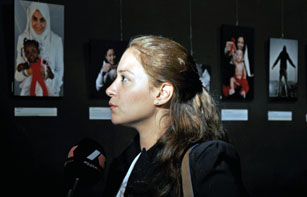
Menna Shalabi, UNAIDS National Goodwill Ambassador for Egypt at the launch of the photo exhibition.
Mr Shazly, who is a professional photographer of note, commented that the photographs were so expressive and profound that they communicated to both the heart and mind. In his opinion, the sense of solidarity around a common cause is what drove the popular uprising and revolution in Egypt. “The HIV response needs to solicit the same sense of unity and people living with HIV should realize they have the power to make that happen,” he said.
Wessam El Beih, UNAIDS Country Officer Egypt explains that the idea to combine photographs was, “to emphasize that overcoming the fear and silence barrier is key to galvanize action that brings about change and the realization of rights.”
Three winners of the 2010 HIV photo contest were presented with digital cameras sponsored by Canon during the launch. The first prize winner, Dina Ezzat, explained that her child was the inspiration behind her photograph. According to Ms Ezzat, the image of a baby wrapped in a red ribbon symbolizes that the future can be bright and free from HIV, and that there is an obligation for society to protect that future through an effective AIDS response.
Related

Feature Story
On the front line: Report outlines progress made and the obstacles encountered in implementing Security Council Resolution 1308
19 May 2011
19 May 2011 19 May 2011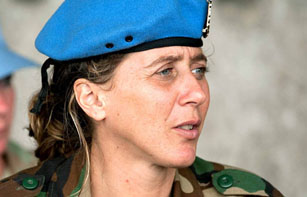
Credit: UN Photo/Marie Frechon
The Joint United Nations Programme on HIV/AIDS (UNAIDS) and the United Nations Department of Peacekeeping Operations (DPKO) have published On the front line: A review of programmes that address HIV among international peacekeepers and uniformed services 2005–2010. This report outlines the progress made and the obstacles encountered in implementing Resolution 1308 and will serve as background when the Security Council meet on 7 June to deliberate progress towards the resolution.
In 2000 when the United Nations Security Council adopted Resolution 1308 it was a watershed moment in the global AIDS response. It was the first time in its history that the Security Council unanimously adopted a resolution addressing a public health concern and its implications for international peace and security.
There are clearly new opportunities for consolidating the progress and addressing new challenges. The imperative to further explore the relationship between AIDS and insecurity is also clear
Michel Sidibé, UNAIDS Executive Director and Alain Le Roy, Under-Secretary-General for United Nations Peacekeeping Operations
The resolution recognized that societal violence and instability exacerbate the spread of HIV and, left unchecked, could pose a threat to international peace and security. It called on UNAIDS and DPKO to develop HIV-specific strategies and programmes within the context of United Nations peacekeeping operations.
The report notes that significant progress has been made in providing access to HIV prevention, treatment, care and support services for all sections of society—including peacekeepers and other uniformed services personnel. Nevertheless, during the past 10 years, the evolving landscape of crises and conflicts throughout the world has reshaped these challenges and underscored the need for a new response to AIDS in the context of United Nations actions to help prevent conflict, ensure security and build peace.
Writing in the introduction, Michel Sidibé, UNAIDS Executive Director and Alain Le Roy, Under-Secretary-General for United Nations Peacekeeping Operations note: “There are clearly new opportunities for consolidating the progress and addressing new challenges. The imperative to further explore the relationship between AIDS and insecurity is also clear.”
External links
Publications
Publications
- On the front line: A review of programmes that address HIV among international peacekeepers and uniformed services 2005–2010 (UNAIDS/UNDPKO, May 2011)
- The Responsibility of the Security Council in the Maintenance of International Peace and Security: HIV/AIDS and International Peacekeeping Operations (UNAIDS/UNDPKO, May 2011)
- HIV/AIDS security and conflict: new realities new responses (AIDS Security and Conflict Initiative, 2010)

Feature Story
Prime Minister of Bangladesh highlights country’s HIV success story during World Health Assembly
18 May 2011
18 May 2011 18 May 2011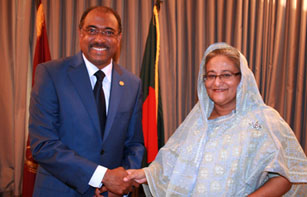
Credit: UNAIDS
In her keynote address to the 2011 World Health Assembly, taking place in Geneva from 16-24 May, Prime Minister of Bangladesh Her Excellency Sheikh Hasina highlighted the progress made by her country in the response to HIV. “In Bangladesh, we have been able to keep HIV prevalence rates to less than 0.01% due to our effective national programme aided by our strong inherent social values. The decline has been due to rapid expansion of HIV services and dedicated AIDS financing.”
Ms Hasina also noted that although progress has been made in the global response to HIV, due attention and continued support from international community should continue.
The Prime Minister of Bangladesh discussed the serious impact that HIV has on migrant workers during a bilateral meeting with UNAIDS Executive Director Michel Sidibé. More than five million Bangladesh citizens work abroad, mostly in the Middle East region, where many face lack of HIV services due to their migrant status which can make people even more vulnerable to HIV infection.
In Bangladesh, we have been able to keep HIV prevalence rates to less than 0.01% due to our effective national programme aided by our strong inherent social values
Prime Minister of Bangladesh Her Excellency Sheikh Hasina
During the meeting, Mr Sidibé recognized the special contribution of the Government of Bangladesh to United Nations Peacekeeping Operations. Bangladesh is ranked first in terms of its contribution, with more than 10 000 military and law enforcement personnel attached to various UN peacekeeping forces worldwide. UNAIDS is working closely with the members of the UN Security Council to review programmes that addresses HIV among international peacekeepers and uniformed services.
The UNAIDS Executive Director also took the opportunity to commend the Government of Bangladesh for hosting the opening of the 2011 Cricket World Cup, which featured messages on HIV-related stigma and discrimination. According to Mr Sidibé, “the Government of Bangladesh and the International Cricket Council demonstrated that cricket is a powerful force for promoting respect and dignity of people living with HIV.”

Feature Story
New draft AIDS strategy high on the World Health Assembly agenda
16 May 2011
16 May 2011 16 May 2011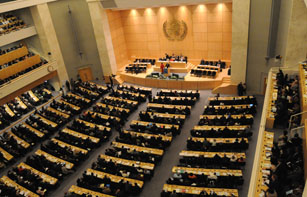
Credit: WHO/Oliver O'Hanlon
The full adoption of the new draft World Health Organization (WHO) global health strategy for HIV 2011-2015 will be a key focus of discussion at the 64th World Health Assembly, taking place in Geneva from 16-24 May and attended by Health Ministers and officials from more than 190 countries. Intended as a global call to action, the comprehensive draft strategy maps out the WHO latest guidance and approaches to successfully challenging today’s evolving AIDS epidemic.
The World Health Assembly, the highest decision-making body of the World Health Organization which sets policy and approves the budget, will also debate a multiplicity of other issues. These include: pandemic influenza preparedness, cholera and the mechanism for control and prevention, infant and young child nutrition, youth and health risks, safe management of drinking water, climate change and health prevention and control of non-communicable diseases and malaria. The future of financing for WHO will also be high on the agenda.
Today WHO Director-General Dr Margaret Chan will address the Assembly and on 17 May invited speakers Mrs Sheikh Hasina, Prime Minister of Bangladesh, and Bill Gates, Co-chair of the Bill & Melinda Gates Foundation, will take the floor.
Four technical meetings, ranging from public health concerns and radiation health to information and accountability for the health of women and children are also scheduled.
In addition to setting policy, the Assembly will give the gathered government representatives, medical professionals and academics the chance to exchange ideas and experiences. Regional meetings for Ministers of Health are set to provide an opportunity to explore specifically relevant issues.
External links
External links
Related

Feature Story
Brazil’s Minister of Health and UNAIDS Executive Director discuss strategic collaboration opportunities
16 May 2011
16 May 2011 16 May 2011
Credit: UNAIDS
In the sidelines of the World Health Assembly, taking place in Geneva from 16-24 May, UNAIDS Executive Director Michel Sidibé and Brazilian Minister of Health Alexander Padilha met to discuss the global AIDS response and promote South-South cooperation.
Mr Sidibe and Mr Padilha talked about the participation and role of Brazil during the upcoming General Assembly High Level Meeting on AIDS that will take place in New York from 8-10 June 2011.
HIV treatment for prevention was highlighted as one of the country’s success stories and an area where Brazil could drive the push for innovation and transfer of technologies between countries. Both leaders also reflected the sports and HIV advocacy opportunities provided by the FIFA World Cup that will be hosted by Brazil in 2014.
Related

Feature Story
Fourth United Nations Conference on the Least Developed Countries hosts high level debate on gender equality and empowerment of women
16 May 2011
16 May 2011 16 May 2011
Dr Paul DeLay, UNAIDS Deputy Executive Director, Programme
Credit: UNAIDS
The fourth United Nations Conference on the Least Developed Countries (LDC-IV) ran 9-13 May in Istanbul, Turkey. Member states met to discuss objectives and targets for the next decade 2011-2021.
According to Mithat Rende, coordinator for the LDC-IV, "There are 48 least developed countries in the world with a population of 950 million.” These countries account for 12% of the world’s population and an estimated half of people in these countries live in conditions of extreme poverty.
To place gender equality and the empowerment of women at the centre of discussions on human and social development, a high level interactive debate was held on 12 May.
The debate, which brought together leaders in the field of governance, development and United Nations bodies, was co-chaired by Peter Shanel Agovaka, Minister of Foreign Affairs & External Trade, Solomon Islands and Steven Vanackere, Vice-Prime Minister and Minister of Foreign Affairs, Belgium.
UNAIDS Deputy Executive Director, Programme, Paul De Lay described how an effective and sustainable AIDS response has created solidarity and cohesion around common priority issues across the development spectrum. Addressing the underlying social and economic drivers of the epidemic and companion health, development and rights challenges helps catalyze positive social change and accelerate development. He noted, “Successes will depend on the engagement of key populations in every facet of the response.”
“Removing common barriers that unblock progress on AIDS, such as gender inequality, also advance progress on maternal and child health and universal education,” Dr De Lay said. “The AIDS response has built bridges for health, development and human rights,” he added.
Development, gender inequality, and HIV
The 2010 Human Development Report showed that the countries with low human development score highest in a Gender Inequality Index. Women in these countries have lower access to education and economic opportunities, and lack of a political voice.
Women make up around half of all people living with HIV and 76% of women living with HIV live in sub-Saharan Africa. Some 30 years since AIDS was first reported, persistent gender inequality and human rights violations continue to put women and girls at a greater risk of and vulnerability to HIV.
Removing common barriers that unblock progress on AIDS, such as gender inequality, also advance progress on maternal and child health and universal education
Dr Paul DeLay, UNAIDS Deputy Executive Director, Programme
These obstacles are hampering progress and threaten the gains that have been made in preventing new HIV infections and in increasing access to treatment. In addition to their biological susceptibility to HIV, women and girls face many interacting socio-cultural, economic and legal challenges that amplify their vulnerability.
The participants discussed the need to define concrete goals that can be evaluated by better data in order to mainstream gender and social protection in a meaningful way into development programmes. Ensuring that social protection policies are gender responsive and inclusive are seen as critical components of this agenda for future action. There was a call for smart investments in women and girls and the need to invest in young people including in their education and reproductive health.
Ensuring universal access
Earlier in the week Dr De Lay moderated a side event on Ensuring universal access to HIV prevention, treatment, care and support services: country perspectives during which he gave an overview of the history of universal access. Looking ahead to next month’s General Assembly gathering he said, “The 2011 High Level Meeting from 8–10 June will present a unique opportunity to review progress and reinvigorate the AIDS response. The time has come to reaffirm commitments against global targets.”
A keynote speech was delivered on behalf of Bathabile Olive Dlamini, South Africa’s Minister of Social Development, by Zane Dangor, Special Advisor to the Ministry, Department of Social Development. The speech presented the outcomes of the International Advisory Group on Universal Access which convened recently in Johannesburg, and discussed progress in HIV in the broader context of solidarity for human rights. He stressed that the AIDS movement has proved that human rights are not just about values and ideology: protecting human rights is a requirement for saving lives. Panelists from Tanzania, Nepal and the African Union illustrated this point with powerful experiences working with national AIDS programmes, young people, communities and families in scaling-up to universal access.
External links
Related

Feature Story
Move it! AIDS campaign launched to rally support for the High Level Meeting on AIDS in June
16 May 2011
16 May 2011 16 May 2011
Five-year-old Sophia on her Move it! decorated bike during the launch event of the campaign outside the UN in Geneva.
Credit: UNAIDS
HIV activists, bike enthusiasts, and community members gathered in front of the United Nations in Geneva on 13 May, to launch the television and social media campaign Move it! The campaign aims to create a movement of support for a successful outcome at the United Nations General Assembly High Level Meeting on AIDS in New York from 8-10 June 2011.
Amid HIV bike decorations and music, a more serious matter drew people together on the square. While more than six million people are now accessing treatment in low and middle income countries, and people around the world are adopting safer sexual practices, gains are fragile. There are still about nine million people waiting for treatment, and 2.6 million people were newly infected with HIV in 2009.
The High Level Meeting on AIDS is an opportunity to shift gears in the AIDS response. To raise awareness in the lead up to the High Level Meeting, we are launching the Move it! campaign
Tim Martineau, UNAIDS Director, Programme Effectiveness and Country Support Department.
“The High Level Meeting on AIDS is an opportunity to shift gears in the AIDS response. To raise awareness in the lead up to the High Level Meeting, we are launching the Move it! campaign,” said Mr Tim Martineau, UNAIDS Director, Programme Effectiveness and Country Support Department. “Without public expectations, we cannot be sure of a successful outcome. Social Media offers an excellent channel to rally such support,” he added.
The campaign will run on social networks from the launch event in Geneva, during three weeks in the lead up to the High Level Meeting on AIDS. People around the world can creatively decorate their bikes with AIDS awareness materials and share photos of their creations on the UNAIDS Facebook page. UNAIDS fans on Facebook will be able to vote for the best bike in early June.
Move it! uses the bike as a vehicle to raise awareness about HIV, with the spinning wheel symbolizing the movement and force of the AIDS response. Anyone can participate and take awareness messages to the streets:
“I like the way the red ribbons go round and around on my wheels,” said five-year-old Sophia decorating her bike.
The campaign will culminate on 5 June in New York City, ahead of the opening of the High Level Meeting. A campaign video has been developed that will be aired across Africa, and will also be available on UNAIDS YouTube channel.
To find out how to get involved visit www.facebook.com/UNAIDS or join the conversation on Twitter
External links
External links

Feature Story
International Advisory Group calls for global solidarity to achieve universal access to HIV prevention, treatment, care and support
16 May 2011
16 May 2011 16 May 2011
The International Advisory Group (IAG) on universal access met in Johannesburg, South Africa on 26-28 April 2011 to crystallize key findings informed by the outcomes of recent series of country and regional consultations on universal access. The meeting was an opportunity to gain consensus on global priorities and the “way forward” which is captured in the IAG statement, Solidarity for Universal Access. The IAG is co-chaired by Mrs Bathabile Dlamini, Minister of Social Development, Republic of South Africa and Dr Paul De Lay, UNAIDS Deputy Executive Director, Programme.
The statement will be shared directly with Member States to contribute towards negotiations on a draft declaration in lead up to the United Nations High Level Meeting on AIDS that will take place in June.
Between 2010 and 2011, 117 countries took stock of their progress towards universal access to HIV prevention, treatment, care and support services. The national assessments informed multiple regional consultations.
While reviewing the findings from the country and regional consultations, the IAG, a multi-stakeholder advisory group, mandated by the UNAIDS Programme Coordinating Board, found overwhelming and ongoing support for the universal access movement.
We need to strengthen the human rights approach in our response to AIDS and establish mechanisms to ensure that both public and private services are free of stigma and discrimination or homophobia
Dr Jose Angel Cordova Villalobos, Secretary of Health of Mexico and member of the IAG
During the April meeting in South Africa, the IAG endorsed the recommendations from the regional and country consultations and concluded that five global challenges are pivotal now to achieve universal access to HIV prevention, treatment, care and support by 2015. These global challenges include the need to protect the human rights of all people; improve access to quality and affordable HIV treatment and scale up HIV prevention programmes; engage inspiring and courageous leaders, especially young people, lead the response; use evidence-informed strategies to make smart investments that will yield maximum results; and, finally, share accountability.
“We need to strengthen the human rights approach in our response to AIDS and establish mechanisms to ensure that both public and private services are free of stigma and discrimination or homophobia,” said Dr Jose Angel Cordova Villalobos, Secretary of Health of Mexico and member of the IAG during his participation in the Latin America consultation in March this year.
The advisory body emphasizes in its statement that global solidarity on the identified key priorities will change the trajectory of the epidemic, save lives and contribute towards achieving the UNAIDS vision of zero new HIV infections, zero discrimination and zero AIDS-related deaths.
Publications
Related

Press Release
Groundbreaking trial results confirm HIV treatment prevents transmission of HIV
12 May 2011 12 May 2011WHO and UNAIDS hail results from the HPTN 052 trial that show antiretroviral therapy to be 96% effective in reducing HIV transmission in couples where one partner has HIV
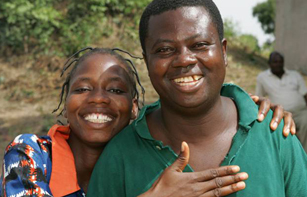
Credit: UNAIDS/P.Virot.
GENEVA, 12 May 2011—Results announced today by the United States National Institutes of Health show that if an HIV-positive person adheres to an effective antiretroviral therapy regimen, the risk of transmitting the virus to their uninfected sexual partner can be reduced by 96%.
“This breakthrough is a serious game changer and will drive the prevention revolution forward. It makes HIV treatment a new priority prevention option,” said Michel Sidibé, Executive Director of the Joint United Nations Programme on HIV/AIDS (UNAIDS). “Now we need to make sure that couples have the option to choose Treatment for Prevention and have access to it.”
The trial, conducted by the HIV Prevention Trials Network, enrolled more than 1 700 sero-discordant couples (one partner who is HIV-positive and one who is HIV-negative) from Africa, Asia, Latin America and the United States of America.
Only people living with HIV with a CD4 cell count of between 350 and 550, thus not yet eligible for treatment for their own health according to latest WHO guidelines, were enrolled in the study. The reduction of sexual transmission of HIV was so significant that the trial was stopped 3-4 years ahead of schedule.
"This is a crucial development, because we know that sexual transmission accounts for about 80% of all new infections," said Dr Margaret Chan, WHO Director-General. "The findings from this study will further strengthen and support the new guidance that WHO is releasing in July to help people living with HIV protect their partners."
The availability of Treatment for Prevention will not only empower people to get tested for HIV, but also to disclose their HIV status, discuss HIV prevention options with their partners and access essential HIV services. It will also significantly contribute to reducing the stigma and discrimination surrounding HIV.
“People living with HIV can now, with dignity and confidence, take additional steps to protect their loved ones from HIV,” said Mr Sidibé.
It is currently estimated that only about half of the 33 million people living with HIV know their HIV status. An increase in the uptake of testing for HIV would have a significant impact on the AIDS response, particularly if more people gain access to treatment in light of the new findings.
UNAIDS and WHO recommend that couples make evidence-informed decisions on which combination of HIV prevention options is best for them. UNAIDS urges that Treatment for Prevention be one of the options made available to couples. The new WHO guidelines coming out in July will help countries to make this a reality for people who choose to use this new HIV prevention option. The guidelines will include specific recommendations on increasing access to HIV testing and counseling and the use of antiretroviral therapy among discordant couples.
No single method is fully protective against HIV. Treatment for Prevention needs to be used in combination with other HIV prevention options. These include correct and consistent use of male and female condoms, waiting longer before having sex for the first time, having fewer partners, male circumcision, and avoiding penetrative sex. The significance of the findings put Treatment for Prevention firmly in the HIV prevention package.
To increase access to the Treatment for Prevention option, the Treatment 2.0 initiative must be urgently implemented to innovate, simplify, reduce costs and mobilize communities to scale up HIV testing and counseling and treatment.
UNAIDS will convene a partners meeting to further discuss this new development and its implications for the AIDS response. This builds on a series of expert consultations which have been convened by UNAIDS and WHO on Treatment for Prevention during the last two years.
UNAIDS and WHO will work with countries and partners to make Treatment for Prevention an integral part of the HIV response and to ensure it is made available to people who wish to use it as soon as possible.
Contact
UNAIDS GenevaSophie Barton-Knott
tel. +41 22 791 1697
bartonknotts@unaids.org
WHO Geneva
Tunga Namjilsuren
tel. +41 22 791 1073
namjilsurent@who.int
Press centre
Download the printable version (PDF)

